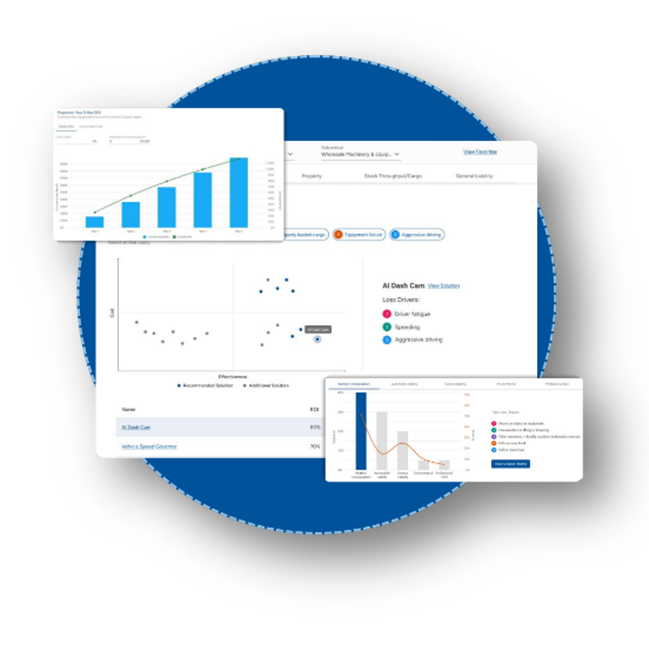Property & Casualty Insights
Uncover Risks and Unlock Significant ROI With Smarter Insights
JULY 1, 2025
Insurance claims are not random events — they are symptoms of deeper operational vulnerabilities. Whether it’s workplace injuries, property damage, or cyber incidents, each claim tells a story. The challenge is connecting those stories to actionable insights. That’s where data-driven risk control becomes a game changer.
Organizations need more than historical claims data; they need real-time, industry-specific insights that identify top loss drivers across lines of coverage. This level of clarity allows for targeted interventions that not only reduce claims, but also improve outcomes and deliver a measurable return on investment (ROI).
When risk control is targeted and data-driven, the financial impact can be substantial. For example, USI clients who implemented personal safety alert devices in their workplaces saw a 9:1 return on investment in the first year alone. In broader terms, companies that align risk control with their specific exposures have reported premium reductions of up to 30%.
The Shift From Reactive to Proactive Risk Management
Traditional risk management often relies on generalized data and outdated solutions. However, what works for a logistics company may be irrelevant to a healthcare provider. Risk control must be tailored to the unique exposures of each organization.
An effective approach starts with your data, including claims history, operational metrics, and industry benchmarks. From there, it’s possible to pinpoint the specific coverage areas (e.g., workers’ compensation, general liability, auto) that are driving costs. Once these are identified, organizations can evaluate targeted solutions designed to mitigate those risks.
Six Steps to Smarter Risk Control
To reduce costs and improve claim outcomes, consider the following strategic framework:
- Start with your industry and data — Avoid generic benchmarks. Use data that reflects your specific operations, size, and geography.
- Focus on high-impact coverage lines — Identify which lines of coverage are contributing most to your claim costs.
- Identify top loss drivers — Drill down into the root causes of losses within each coverage line.
- Evaluate targeted solutions — Assess available risk control measures that directly address your top loss drivers.
- Prioritize based on ROI — Allocate resources to solutions that offer the highest return on investment.
- Leverage strategic partners — Collaborate with brokers, carriers, and vetted third-party vendors to implement and monitor solutions effectively.
Strategies With a Positive Business Impact
USI’s proprietary PATH platform leverages the experience and success of hundreds of thousands of commercial insurance clients to develop and recommend innovative, cutting-edge solutions designed to mitigate the top sources of loss by industry.
Consider the following scenario: a manufacturing company is facing increasing workers’ compensation costs and is looking to determine the most cost-effective way to decrease these expenses. PATH helps the client identify the top loss drivers, including being struck by objects, overexertion, slips/trips/falls, repetitive motion, or being caught in or between objects. The platform then provides a solution matrix from hundreds of potential solutions to identify which ones might best address these issues.
Among several effective solutions, one is wearable technology — a lightweight device that an employee attaches to their waist, arm, or back to help prevent injuries. Using the PATH financial calculators, the client can estimate the year-one ROI based on its loss history. In this scenario, the company experiences approximately 11 losses annually at an average cost of $60,000 per incident, generating $300,000 in annual losses. Investing in this wearable technology solution would cost $32,000, generating year-one savings of $180,000 — a 460% return on investment.i
PATH then generates a five-year ROI projection based on different plan components and a list of 20 potential vendors for the client that offer the recommended technology. This projection includes a detailed feature comparison and evaluation score of the vendors, along with preferred pricing. Curated vendor partnerships can streamline implementation and reduce costs. The client can customize the analysis based on various inputs, with revised results and calculations being generated within seconds.
How USI Can Help
PATH™ – Uncover Top Business Risks & Unlock Significant ROI
USI PATH is a proprietary risk control platform that delivers an interactive and transparent journey through the complex risk-control process. Offering indisputable data and a clear view into your industry risk profile, PATH provides:
- Valuable insights into key loss factors and their impacts through a real-time, interactive experience.
- A way to uncover areas of potential improvement for your risk control programs and a path toward better claims results.
- Curated vendor solutions with preferred pricing and ROI projections.

PATH will enable you to gain clear insights with visibility into top loss drivers and impact, including improvement areas by line of coverage to generate meaningful ROI and improve claims and outcomes.
2,409+
Risk control
solutions available
96%
Solutions offering
multiple products to
better address your needs
9:1
ROI on personal
safety alert devices
noticed in year 1
To learn more about USI PATH and our targeted approach to risk management, contact your USI representative or email pcsolutions@usi.com.
i This assumes the company uses a loss-sensitive program. While a guaranteed-cost program would not receive the immediate full impact of a reduction in claims, the five-year cumulative premium savings could be $135,000.
SUBSCRIBE
Get USI insights delivered to your inbox monthly.
